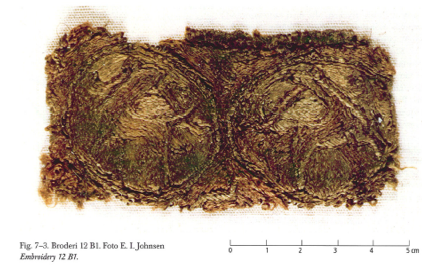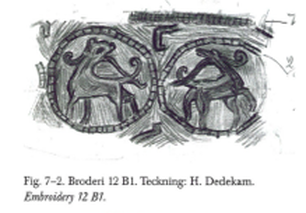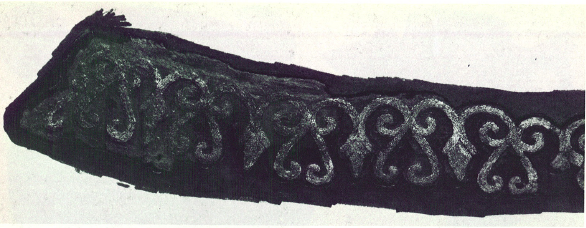Embroidery, while evidenced, was not common, and often what we have is considered to be imported goods.
First, let me make a comment about how I differentiate types of embroidery that are often discussed among reenactors. Often I see someone come onto a forum and ask about Viking embroidery. Others quite often launch into long dissertations about how Vikings did not do embroidery. What the poster sometimes means, however, is often not figurative, large-scale embroidery, but rather the seam embellishments that are frequently employed by reenactors. For the purpose of this post I am going to categorize those three types differently as “seam embellishments”, "functional stitches" and “embroidery”.
Seam embellishment, while (in my opinion) over done by reenactors (myself included), is at least plausible and in evidence in several places. The Hedeby Harbor aprondress fragment had a braid applied over a dart. There is also mention of embroidery covering a seam in one of the Oseberg scraps and some of the apron dresses from Birka had narrow cording sewn to the top edge of the garment.
Functional stitches, on the other hand, are exactly what they sound like. They are stitches that serve a purpose (to create a seam or to hold open the seam allowance) but because part of the stitch rests on the surface of the cloth, it can be quite attractive when stitched in a different color of thread. (Even something as simple as unbleached linen thread against a dark blue dyed linen garment can be striking in its simplicity.)
(Note 9/22/15: I was rereading Hilde Thunem's excellent paper on aprondresses and am really thinking hard about a remark the author made "Inga Hägg comments that the hemming stitches would usually be invisible on wool, but would show up clearly on linen. She believes that the reason that the band has been placed lower on the linen smokkr could be to cover the stitches." I need to go back and look at Hägg's comments and some other things as well. I want to chart out the extant seams from various finds and see what I can figure out about the visibility of the stitching and the threads used. It could well be that they Viking era Norse preferred a very clean look, with little in the way at all of stitches showing.)
Ideas for using seam embellishment and functional stitches to create a more accurate impression:
- Dot not cover every inch of a garment with decorated seams.
- Fine cord or braided string as an edging has ample evidence (on apron dresses a string, especially if it were linen or silk, at the top might serve a functional purpose in helping the top of the garment to not stretch as much with wear).
- If the stitch serves a functional purpose, it actually makes more sense in use (example a running or overcast stitch on the surface that actually is part of a hem). There is one example from the Hedeby Settlement (S 27) that uses buttonhole stitch to join two textiles. Note though, that that was only one of several types of stitches used on that garment. (S 27 information added 9/30/15)
- Keep stitches narrow and compact, there is no evidence of an inch wide herringbone stitch anywhere.
- If you must add stitching, employ stitches that were used in period – examples of some stitches are running stitch, stem stitch, split stitch, osenstitch (though most of the the extant examples of this are metalwork). Note here that while we as reenactors love herringbone, evidence for its use in period is actually quite limited. It was used on a pouch from York and on the INSIDE of a hem at Hedeby. A stitch similar to herringbone was used on the Mammen cushion cover (decorative item rather than a garment) and on the collar of the Skjoldehamn tunic (which may or may not even be Viking), but it was not the sprawling herringbone seen in the reenactment community. For a deeper look at Herringbone see my post HERE.
And now on to the controversial topic of larger, decorative embroidery.
The examples that we have are often are thought to have been Saxon, Rus or Byzantine imports (the first is thought to be the case with the larger Oseberg pieces in particular). It is very important to understand that some of these were also considered to likely be from decorative goods, rather than garments. This proves that the technique of heavily filling an area with stitching existed at the time, it does not at all indicate that this was applied to garments in period. Also worthy of note is that all of these items were very, very high status.
Mistress Þóra Sharptooth has a good article about extant embroidery here: http://www.cs.vassar.edu/~capriest/vikembroid.html
- Use embroidery very, very sparingly.
- Use appropriate stitches, threads and colors.
- Only use embroideries for very wealthy personas of high status and use the embroidery only on textiles worthy of that class. Look for high thread counts and a well-dyed cloth in period appropriate colors.
- Be conscientious in your chose of patterns and motifs. Celtic knotwork is always inappropriate for a Viking kit. Yes, there is fabulous Jelling style knotwork that lends itself well to embroidery, but nothing has been found to support the notion that these motifs were replicated in textiles.
- Scale is very important. Most of the extant pieces are quite small.
- Consider using embroidery that uses only outline as some of the items from Mammen did.
- Or, consider researching Saxon, Rus or Byzantine embroidery, creating a piece and then cutting it down for use on a Viking kit (as if your persona had traded for the item and then re-purposed it as decoration). Actually, that could be a pretty interesting project, maybe I will try that!
The Argument
Often someone will have their heart set on embroidering a large scale, fantastical beast onto a garment and when looking for advice they are confronted with the facts that this style of decoration seemingly did not exist in our period. The most common argument I have heard to defend their position is that that people had “all winter trapped indoors to work on these things”.
Yes, there were long winters, but people were as busy then as they were at other times of the year. Women were responsible for spinning, weaving and sewing garments for their entire family. Yes, a wealthy woman might have had slaves or servants to help with these tasks, but that also means that those slaves and servants also needed to be clothed.
Let us look for a moment at the time involved in just these tasks. In Tools for Textile Production by Eva Andersson, the author comments on experiments in which she took part that showed wool could be spun at 21 yards an hour while the experiments at Ribe show that an average of 61 yards of linen could be spun an hour. (The difference in the two is that the combing included in the wool time from Andersson’s work, whereas the flax would have already been prepared before the spinning begins).
If I need 3 yards of 50” wide fabric for a dress (that is roughly what I use for the tunic type gowns I wear under my aprondresses) and I want to craft a textile that is 25 ends per inch for the warp, I need 4200 yards for my warp. If the weft was slightly thicker yarn (as was often the case) and set at 18 picks per inch, I would need 3478 yards of weft. That is 7678 yards of yarn for one garment. Based on the prep/combing/spinning time that Andersson lists you would need 365 hours to accomplish JUST the spinning portion of your garment creation. If you work on this for ten hours a day, you are looking at over 36 days just spent spinning for a solitary garment.
(And because we are discussing embellishment, which is something reserved for higher classes, here is the calculation for a more finely crafted textile than the modest one mentioned above. With a warp sett of 50 ends per inch (knowing that this is still not nearly as fine as some of the extant textiles), I would need 8400 yards of warp yarn and another 5799 yards of weft that would be set at 30 threads per inch. 676 hours of spinning.)
Both the experiments at Ribe and Andersson agree that setting up the loom takes 2 days of work (approximately 20 hours of time total). Weaving was listed as 27-31 inches a day by Andersson. That 25epi tunic I would make for myself would take me over 3 and a half days to weave if I spend 10 hours a day doing nothing but that.
The result of all of those figures? One dress of decent, but not exceptional cloth, takes approximately 43 days of work at 10 hour days. And this does not include time spent cutting or sewing, this is merely time spent in textile production. Consider then that I would likely also need a smokkr (aprondress) and possibly a new caftan or mantle. And do not forget that one would also be crafting garments for a spouse and children.
I simply find it implausible that there was much time to spare even when "trapped" indoors in the winter.
Assume now that when you are finished with the necessities to cloth your family or fill your house and that you do indeed have extra time. Would you embellish your attire as befits your station? Certainly! I think, however, that would you would choose to add silk strips to your garments (which would provide a costly, but time effective embellishment), or use the thrums from weaving to decorate a seam, or make use of tablet weaving which is a technique that is already considered a status symbol in your community, as is evidenced by the number of wealthy finds that include tablet weaving. Additionally, it is likely that there is a long tradition of this type of weaving in the Viking areas and this skill been passed down to you by your mother or grandmother. There is far more logic and evidence to me to support the use of these techniques, rather than the assumption that someone would have chosen to employ elaborate embroidery (which they may indeed never have even seen in their life, which means essentially they would be inventing a new art form...).
Understand that my goal with this article is not in anyway to stifle an individual’s creative spirit when it comes to embellishing their costume! I enjoy seeing creative works and often compliment artisans on the skill it took to construct their elaborate garments. Instead, I am giving my own personal reasoning based on my research as to what I think is realistic in terms of Viking embellishment and why some techniques might have been used more often than others.
And note also that I do not discount that someday we could find that even a farmer's wife did indeed own heavily embroidered clothing. Personally, I would love to see that, and when it happens, I will happily revise my thoughts on this subject! :-)



 RSS Feed
RSS Feed